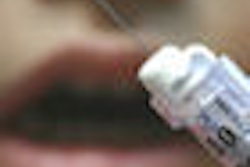
The death of a Chicago patient may illustrate some perils involved in conscious sedation, according to Joel Weaver, D.D.S., Ph.D., president of the American Society of Dentist Anesthesiologists.
The state of Illinois last week suspended the licenses of Chicago dentists Joseph Feldman, D.D.S., and his brother Laurence Feldman, D.D.S., after a patient died during sedation in their office. The patient -- elementary school principal Georgette Watson -- was undergoing root canal therapy, according to news reports.
The Illinois Department of Financial and Professional Regulation (IDFPR) charged the brothers with failing to take a proper medical history of the patient, administering excessive doses of mepivacaine (Carbocaine) and meperidine (Demerol), failing to properly monitor the patient's vital signs during the procedure, and failing to ensure adequate training for their staff.
The Feldmans could not be reached, and their attorneys did not respond to requests for comment.
According to an IDFPR petition, "on or about" December 17, 2007, the Feldmans gave Watson 7 mg of intravenous midazolam (Versed), 75 mg of intravenous meperidine (Demerol), 0.7 mg of intravenous atropine, 6 mg of intravenous dexamethasone, 1 carpule of 2% lidocaine (1:100,000 epinephrine), and 3 carpules of 3% mepivacaine (Carbocaine).
“If the patient moves their arm, it's not unlikely that a steel rigid needle would poke out of the vein.”
— Joel Weaver, D.D.S., Ph.D.
These dosages and combinations of drugs are not unusual, Dr. Weaver said, but the combination might prove excessive for some people. "Seventy-five mg intravenous meperidine is within the usual dosage," he said. "Added to 7 mg midazolam, that's a lot."
Midazolam (a benzodiazepine) was apparently the principal sedative, with meperidine (a narcotic) as an adjunct. According to the Drug Information Handbook for Dentistry (2007 Lexi-Comp), the usual dosage for midazolam is 5 mg, depending on the patient's body weight. However, the handbook warns, "if narcotics or other CNS depressants are administered concomitantly, the midazolam dose should be reduced by 30%."
Atropine is used to reduce saliva and dexamethasone is an anti-inflammatory. Licodaine and mepivacaine are both anesthetics. "Dentists often don't consider how much local anesthetic they're using," Dr. Weaver said. However, three cartridges of mepivacaine contain a total of only 162 mg, and the licodaine carpule another 36 mg, according to the Handbook, so the total anesthetic administered was within the 270 mg maximum dose the book recommends for mepivacaine.
Asked to explain in what way these doses "exceeded the therapeutic doses," Susan Hofer, a spokesperson for the IDFPR, said no one from the agency could comment on the case.
The IDFPR petition also mentions that the dentists administered 2 cc of intravenous naloxone (Narcan), 2 cc of sublingual naloxone, and 2 cc of flumazenil, all in apparent attempt to reverse the sedation drugs.
Dr. Weaver said it would be inappropriate to speculate on what the Feldmans might have done right or wrong. But he noted that it would only be necessary to administer naloxone sublingually if the intravenous route wasn't available.
One common mistake that leads to this problem is the use of a steel needle instead of a flexible catheter in the patient's vein. "If the patient moves their arm, it's not unlikely that a steel rigid needle would poke out of the vein," he said.
The Feldmans will get a chance to tell their side of the story before an administrative law judge August 13.
In the meantime, "the lesson to be learned is you have to follow the ADA guidelines in terms of monitoring" and take appropriate classes to learn the right doses and techniques, Dr. Weaver said.



















